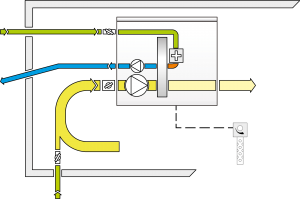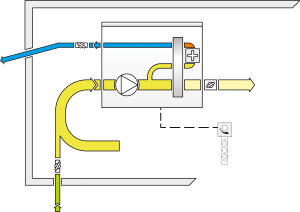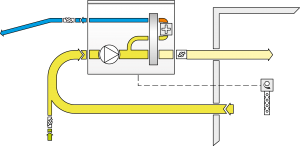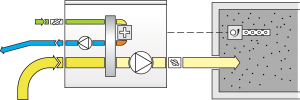
The light green arrow is the air to be dried. When the air passes through the rotor, as the filter is usually called, the rotor takes up most of the moisture contained in the air. When the air comes out, it is dry (yellow arrow). The rotor, in its turn, is dried by a hot air stream which expels the moisture. The rotor rotates and passes through the hot air flow every turn and is continuously dried.
Because a dehumidifier uses warm air, it is important to choose an energy-efficient dehumidifier to keep the electricity bill down. There is a developed heat recovery system for the warm air which will save about one third of the energy.

Desiccant dehumidifier installed within the dehumidified room. The process air is recirculated in a closed system. To provide a positive pressure in the room fresh air can be introduced at the process inlet. If the reaction air inlet duct is omitted, a negative pressure can be created in the room.

Desiccant dehumidifier with internal heat recovery, installed within the dehumidified room. The process air is recirculated in a closed system. To provide a positive pressure in the room fresh air can be introduced at the process inlet. If the reaction air inlet duct is omitted, a negative pressure can be created in the room.

Desiccant dehumidifier installed outside the dehumidified room. The process air is recirculated in a closed system. To provide a positive pressure in the room fresh air can be introduced at the process inlet.

Desiccant dehumidifier installed outside the dehumidified room. The process air is recirculated in a closed system. To provide a positive pressure in the room fresh air can be introduced at the process inlet.

Desiccant dehumidifier with internal heat recovery installed within the dehumidified room. Process air inlet is adjusted to provide positive pressure in the dehumidified room. If the reaction air inlet duct is omitted, a negative pressure can be created in the room.

Desiccant dehumidifier with internal heat recovery installed outside the dehumidified room. The dampers are adjusted to either give a positive or negative pressure in the dehumidified room.

Desiccant dehumidifier with internal heat recovery that is being used to blow in or through an object. It can be in either total loss or in an open system.

Desiccant dehumidifier with internal heat recovery that is being used to blow in or through an object. It can be in either total loss or in an open system.
